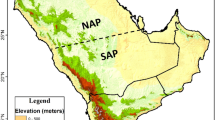Abstract
As part of the development work of the Chinese new regional climate model (RIEMS), the radiative process of black carbon (BC) aerosols has been introduced into the original radiative procedures of RIEMS, and the transport model of BC aerosols has also been established and combined with the RIEMS model. Using the new model system, the distribution of black carbon aerosols and their radiative effect over the China region are investigated. The influences of BC aerosole on the atmospheric radiative transfer and on the air temperature, land surface temperature, and total rainfall are analyzed. It is found that BC aerosols induce a positive radiative forcing at the top of the atmosphere (TOA), which is dominated by shortwave radiative forcing. The maximum radiative forcing occurs in North China in July and in South China in April. At the same time, negative radiative forcing is observed on the surface. Based on the radiative forcing comparison between clear sky and cloudy sky, it is found that cloud can enforce the TOA positive radiative forcing and decrease the negative surface radiative forcing. The responses of the climate system in July to the radiative forcing due to BC aerosols are the decrease in the air temperature in the middle and lower reaches of the Changjiang River and Huaihe area and most areas of South China, and the weak increase or decrease in air temperature over North China. The total rainfall in the middle and lower reaches of the Changjiang River area is increased, but it decreased in North China in July.
Similar content being viewed by others
References
Chen Longxun., Shao Yongning, Zhang Qingfen, and Ren Zhenhai, 1991: Preliminary analysis of climate change during the last 39 years in China.Quarterly Journal of Applied Meteorology,2, 164–174. (in Chinese)
D’ Almeida, G. A., P. Koepke, and E. P. Shettle, Eds., 1991:Global Climatology and Radiative Characteristics. Vol.126,Atmospheric Aerosols, A Deepak Publishing, Hampton, Virginia, 561pp.
Grant, K. E., C. C. Chuang, A. S. Grossman, and J. E. Penner, 1999: Modeling the spectral optic properties of ammonium sulfate and biomass aerosols: Parameterization of relative humidity effects and model results.Atmos. Environ.,33, 2603–2620.
Hansen, J., Mki. Sato, and R. Ruedy, 1997: Radiative forcing and climate response.J. Geophys. Res.,102, 6831–6864.
Hansen, J., Mki. Sato, R. Ruedy, A. Lacis, and V. Oinas, 2000: Global warming in the twenty-first century: An alternative scenario.Proc. Natl. Acad. Sci., U.S.A.,97, 9875–9880.
Haywood, J., and V. Ramaswamy, 1998: Global sensitivity studies of the direct radiative forcing due to anthropogenic sulphate and black carbon aerosols.J. Geophys. Res.,103, 6043–6058.
Haywood, J. M., D. L. Roberts, A. Slingo, J. M. Edwards, and K. P. Shine, 1997: General circulation model calculations of the direct radiative forcing by anthropogenic sulfate and fossil-fuel soot aerosol.J. Climate,10, 1562–1577.
Jacobson, M. Z., 2000: A physically-based treatment of elemental carbon optics: Implications for global direct forcing of aerosols.Geophys. Res. Lett.,27, 217–220.
Jacobson, M. Z., 2001: Global direct radiative forcing due to multicomponent anthropogenic and natural aerosols.J. Geophys. Res.,106, 1551–1568.
Liousse, C., J. E. Penner, C. C. Chuang, J. J. Walton, and H. Eddleman, 1996: A global three dimensional model study of carbonaceous aerosols.J. Geophys. Res.,101, 19411–19432.
Martins, J. V., P. Artaxo, C. Liousse, J. S. Reid, P. V. Hobbs, and Y. J. Kaufman, 1998: Effects of black carbon content, particle size, and aerosols, their direct and indirect effects mixing on light absorption by aerosols from biomass burning in Brazil.J. Geophys. Res.,103, 32041–32050.
Menon, S., J. Hansen, L. Nazarenko, and Y. Luo, 2002: Climate effects of black carbon aerosols in China and India.Science,297, 2250–2253.
Schult, I., J. Feichter, and W. F. Cooke, 1997: Effect of black carbon and sulphate aerosols on the global radiation budget.J. Geophys. Res.,102, 30107–30117.
Streets, D. G., and Coauthors, 2003: An inventory of gaseous and primary aerosol emissions in Asia in the year 2000.J. Geophys. Res.,108(D21), 8809, doi10. 1029/2002JD003093.
Tang Jie, Wen Yupu, Zhou Lingxi, Qi Donglin, Zheng Ming, T. Neil, and W. Erika, 1999: Observational study of black carbon in clean air area of western China.Quarterly Journal of Applied Meteorology,10, 160–169. (in Chinese)
Wang Mingxing, Zhang Renjian, and Pu Yifen, 2001: Recent researches on aerosol in China.Adv. Atmos. Sci.,18, 576–586.
Wang Xihong, and Shi Guangyu, 2002: Effect of cloud and surface albedo on direct sulfate radiative forcing over East Asia.Acta Meteorologica Sinica,60, 758–764. (in Chinese)
William, F. C., and J. J. N. Wilson, 1996: A global carbon aerosol model.J. Geophys. Res.,101, 19395–19409.
Wolf, M. E., and G. M. Hidy, 1997: Aerosols and climate: Anthropogenic emissions and trends for 50 years.J. Geophys. Res.,102, 11113–11121.
Wu Jian, Jiang Weimei, Liu Hongnian, and Tang Jianping, 2002: Simulation of the direct and indirect radiative effects of sulfate aerosol.Acta Scientiae Circumstantiae,22, 129–134. (in Chinese)
Xiong Zhe, 2001: The simulation and analysis of East Asia climate and its interannual variation. Ph. D. Dissertation, Institute of Atmospheric Physics, Chinese Academy of Sciences, 185pp.
Zhang Lisheng, and Shi Guangyu, 2000: The global anthropogenic sulfate and soot data and distribution characteristic of the optical depth.Climatic and Environmental Research,5, 67–74. (in Chinese)
Zhang Lisheng, and Shi Guangyu, 2001: The simulation and estimation of radiative properties and radiative forcing due to sulfate and soot aerosols.Chinese Journal of Atmospheric Sciences,25, 231–242. (in Chinese)
Zhang Ying, and Gao Qinxian, 1997: A study on the radiative effect of sulfate and soot aerosols.Quarterly Journal of Applied Meteorology,8(Suppl.), 87–91. (in Chinese)
Author information
Authors and Affiliations
Corresponding author
Rights and permissions
About this article
Cite this article
Wu, J., Jiang, W., Fu, C. et al. Simulation of the radiative effect of black carbon aerosols and the regional climate responses over China. Adv. Atmos. Sci. 21, 637–649 (2004). https://doi.org/10.1007/BF02915731
Received:
Revised:
Issue Date:
DOI: https://doi.org/10.1007/BF02915731




